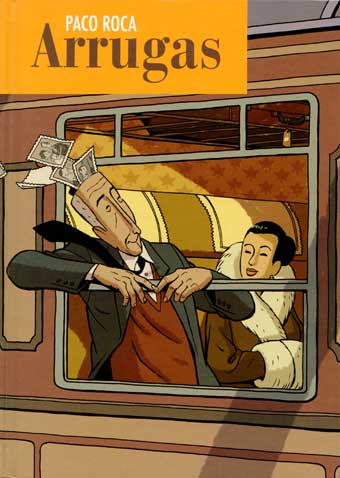Writing with Pictures

One of the comics I picked up in Barcelona last month was Arrugas by Paco Roca, a story about an old man’s encounter with Alzheimer’s Disease. I don’t read Spanish, but visually “reading” it panel to panel at the airport still provided a coherent and sometimes moving experience. Here’s a scan of some early pages to give you a sense of the storytelling. Looking forward to seeing an English edition, it’s clearly a good book.
When I worked at DC Comics in the production department in 1982 (my first job out of college), I spent many lunch hours flipping through the huge collection of untranslated manga at the nearby Kinokuniya, Manhattan’s largest Japanese bookstore. I admired how many could be understood on the strength of their visual storytelling alone. It was refreshing to experience that again.
I met or was introduced to the work of a number of talented artists in Barcelona (many through Astiberri) including Alberto Vazquez, Fermin Solis, David Rubin, Felix Diaz and Tony Sandoval. Most haunting, though, might have been the album I found by French artist Ivan Brun called No Comment, a silent, funny and extremely dark look at modern society.
Writing with pictures (or screaming with pictures, in Brun’s case) in the language of comics.














I can understand the language roughly.
The spokeswoman is telling the couple about how cheap it will be and how good things are on the elderly home, and how they can come and go as they wish. They reply that they are too busy with their work to have much time.
Fade to memory.
-“I… want to leave with my mother…”
—-
I can see what you mean with graphic storytelling, though…
My 3 years of Spanish in high school tell me it means something like this:
Panel 1: The shared living space is cheaper
P2: Plus, the price includes three meals a day
P3: And we manage the medications he has to take
P4: We could definitely take better care of him here than if he stayed in your house.
Page 2
P1: We have elderly residents that have been living here happily for more than 15 years.
P2: Your father would have everything he needs here.
P3: Of course, you can come and see him whenever you want.
P4: Good, but truthfully…we’re really busy with work and this…y’know?
P5: I don’t think we can visit that often.
Page 3: I wa- wanna go be wtih my mom.
…for what it’s worth. Obviously, the whole point of your post is how much can be conveyed with just pictures, but I thought you might be curious anyway.
I remember reading the complete Ranma 1/2 my friend owned which was entirely in Japanese with panel-by-panel translations written out on lined paper. After a little while, I’d only use the translations for a few confusing moments of heavy dialogue, since the rest was conveyed perfectly just through the visuals. Of course, back then you had to get accustomed to certain conventions of conveying emotion (sweat drops, #s on foreheads) that these kids with their Teen Titan shows already grok out of the gate.
When I began researching Moto Hagio for the shoujo-manga issue of The Comics Journal (TCJ #269), I picked up ten volumes of her work at Seattle’s Kinokuniya outlet, and was astonished to discover that a one-paragraph synopsis of her A SAVAGE GOD REIGNS series was all I needed to understand the first four books in the story. The utterly brilliant visual storytelling captivated me, and I’ve been a fan ever since.
[…] “When I worked at DC Comics in the production department in 1982 (my first job out of college), I spent many lunch hours flipping through the huge collection of untranslated manga at the nearby Kinokuniya, Manhattan’s largest Japanese bookstore. I admired how many could be understood on the strength of their visual storytelling alone.” – Scott McCloud […]
I did not know this french artist Ivan brun. He seem to be working in english from over there weird.
I found this interview of him on Youtube… very anoying since we can mainly here a baby crying in the background… poor choice of place for an interview
http://www.youtube.com/watch?v=1-CfphtF0ec
Spain is a great country for comics. The manga storytelling influence there is stronger than in most American comics.
Tony Sandoval was there? Awesome. Last I heard of him he was publishing with Les Humanoids, I think. Glad to hear he’s still representing Mexico all the way. 🙂
Tony Sandoval? I think he is a great artist. Last thing I knew he was doing was “El cadaver y el sofa” and participating in this exquisite corpse comics project. http://cadaver.produccionesbalazo.com/
While I can understand perfectly every page you scanned I also had my share “reading” untranslated manga, quite an experience it can be when the panels are so solid.
eigakantoku traslation of those pages was really great, I said as it is my first languaje, great job!
[…] hits Craft Sean Phillips Pencils John Buscema Rules Writing With Pictures Exhibits/Events Go See Sandra Bell-Lundy’s Stuff History Ike Meets The NCS Interviews/Profiles […]
[…] McCloud introduces his impressions of a book he can’t read, Arrugas by Paco […]
Im spanish student and love your web and make comics. Arrugas is probably one of best spanish comics, but normally cartoonist like Paco Roca don´t sell much comics. In Spain there are a lot of good comics creators and editors but there´s no much money.